The Great Famine of 1845-1849 was the greatest catastrophe in the history of Ireland. The potato crop failed and millions died from hunger. Historians tell us that there was enough food in Ireland to prevent the famine. The recent song 'The Fields of Athenry' has become Ireland's unofficial National Anthem. It was composed by Pete St. John and recorded by Paddy Reilly. It tells the story of a young man who stole corn so that his family would not starve and he was banished to a penal colony.
By a lonely prison wall
I heard a young girl calling
Micheal they are taking you away
For you stole Trevelyan's corn
So the young might see the morn
Now a prison ship lies waiting in the bay.
At the beginning of the year 1845 the state of Ireland was, as it had been for nearly 700 years, a source of grave anxiety to England. Ireland had first been invaded in 1169, and in 1845 it was neither assimilated or subdued. The country had been conquered not once but several times, the population had been brought to the verge of extinction, but an Irish nation still existed, separate and hostile.
The land of Ireland was owned by English landlords who controlled vast estates of over 50,000 acres each. For instance, the local Clanricarde estate amounted to 56,826 acres, with an income of £24,358 per annum in 1883. All the landlords lived in big houses or castles, but some of them lived in England and never saw their estates, which were managed by agents who collected the rents from the tenants. Portumna Castle was the seat of the Clanricarde or De Burgo families. When the Castle was burned accidentally in 1826 they returned to England.
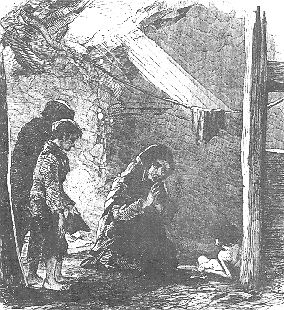 Housing conditions for the Irish were wretched beyond words. The census in 1841 graded 'houses' in Ireland into four classes; the fourth and lowest class consisted of windowless mud cabins of a single room, in which nearly half of the rural population of Ireland lived. In parts of the west of Ireland more than three fifths of the 'houses' were windowless, one roomed mud cabins.
Housing conditions for the Irish were wretched beyond words. The census in 1841 graded 'houses' in Ireland into four classes; the fourth and lowest class consisted of windowless mud cabins of a single room, in which nearly half of the rural population of Ireland lived. In parts of the west of Ireland more than three fifths of the 'houses' were windowless, one roomed mud cabins.
Furniture was a luxury; the inhabitants of a townland in Donegal, numbering about 9,000 had in 1837 only 10 beds, 93 chairs and 243 stools between them. Pigs slept with their owners. The evicted and unemployed put roofs over ditches, burrowed into banks, existed in bog holes. By 1841 when a census was taken, the population had reached 8,175,124, but when the famine came in 1845 the population might well have been above ten million.
All the wretchedness and misery could almost without exception, be traced to a single source - the system under which land had come to be occupied and owned in Ireland, a system produced by centuries of successful conquests, rebellions, confiscations and punitive legislation. These were the principal causes of Irish misery and the bad relations between landlords and tenant.
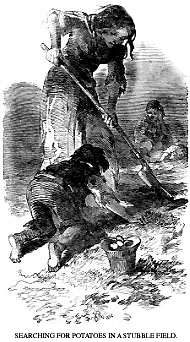 When potatoes were being cultivated 2,385,000 persons were without employment
because there was absolutely no work to offer them. Unless an Irish labourer could get hold of a patch of land and grow potatoes on which to feed himself and his children, the family starved. The land was divided and sub-divided again and again, and holdings were split into smaller and still smaller fragments, until families were attempting to exist on plots of less than half an acre. As the population increased and the demand for a portion of ground grew more and more frantic, land became like golddust in Ireland. The possession of a piece of land was literally the difference between life and death, and as
a result the rents in Ireland were enormous.
When potatoes were being cultivated 2,385,000 persons were without employment
because there was absolutely no work to offer them. Unless an Irish labourer could get hold of a patch of land and grow potatoes on which to feed himself and his children, the family starved. The land was divided and sub-divided again and again, and holdings were split into smaller and still smaller fragments, until families were attempting to exist on plots of less than half an acre. As the population increased and the demand for a portion of ground grew more and more frantic, land became like golddust in Ireland. The possession of a piece of land was literally the difference between life and death, and as
a result the rents in Ireland were enormous.
In the 50 years preceding the famine up to 200 commissions and special committees were instructed to report on the State of Ireland, and without exception their findings prophesied disaster. Ireland was on the verge of starvation, her population rapidly increasing, three-quarters of her labourers unemployed, housing conditions appalling, and the standard of living unbelievably low.
The First Appearance of Blight
The Governments ignored all these reports and instead introduced in July 1838 the Irish Poor Law Act, which stated that the property of Ireland must support the poverty of Ireland, and the menace to England be removed. In other words Ireland must fend for itself. Meanwhile in 1844, a report was received that in North America a disease, hitherto unknown, had attacked the potato crop. In August 1845 Sir Robert Peel, the British Prime Minister received a letter from the Isle of Wight, reporting that the disease had appeared in the potato crop there, and was spreading through England. It was now only a question of time before the blight spread to Ireland. In October it was time for the potatoes to be taken out of the ground. The soundness of the potato when first dug was responsible for bewildering contradictions. Within a few days the fine-looking tubers had become a stinking mass of corruption, and they all rotted. Alarm turned to terror.
On November 3rd a deputation met with the Lord-Lieutenant to urge him to adopt measures to avoid calamity. The deputation included Daniel O'Connell, the Lord Mayor of Dublin and some twenty others. The proposals drawn up by O'Connell called for the immediate stoppage of the export of corn and provisions, and for the prohibition of distilling and brewing from grain. The ports should be opened for the free import of food, rice and Indian corn. The Lord-Lieutenant read aloud a prepared reply.
The Prime Minister decided to repeal the Corn Laws, but did not get backing from his Cabinet and he resigned, but was asked by Queen Victoria to form a new Government. He ordered £100,000 to be spent on Indian Corn, to be purchased in the United States and shipped to Ireland. It proved the decisive factor in relieving the distress of 1845-46. All expenditure required Treasury sanction and the Secretary was the formidable figure of Charles Edward Trevelyan.
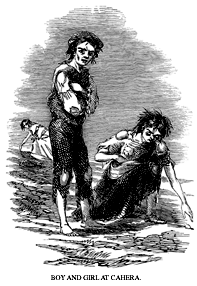 The first Relief Commission started work in November 1845. The influence of Trevelyan was limited, but within a few months he had become director and virtual dictator of Irish relief. It was not until five or six months after the failure of the first crop that famine began, and after every scrap of food, every partially-diseased potato, every fragment that was conceivably edible by human beings had been consumed.
The first Relief Commission started work in November 1845. The influence of Trevelyan was limited, but within a few months he had become director and virtual dictator of Irish relief. It was not until five or six months after the failure of the first crop that famine began, and after every scrap of food, every partially-diseased potato, every fragment that was conceivably edible by human beings had been consumed.
The relief plan devised by Peel fell into four parts. The first and most important was the organisation of local efforts. The second part of the plan consisted of relief schemes. The third part was concerned with the establishment of fever hospitals, and the fourth part involved the sale of Government Indian corn.
The Relief Commission found it difficult to implement the plans. A large number of Irish landlords were hopelessly insolvent. Before public works of any description could be satisfactorily established a great deal of preliminary work must be done. The Indian corn had to be milled and the officials of the Irish Poor Law would not assist.
Evictions
The Marquess of Clanricarde, declared that a great part of Ireland was already in a state of insurrection, and a Coercion Bill was introduced in February. William Smith O'Brien stated in the Commons that the Irish wanted food not soldiers. Throughout these months, as famine in Routh's words was 'steadily and gradually approaching', evictions were reported weekly. Evictions, however were not confined to populations of paupers and squatters living in mud huts. The most notorious instance, was the eviction of 300 tenants by Mrs. Gerrard from the village of Ballinglass, Co Galway, on March 13, 1846. A population reasonably prosperous, according to Irish standards, was evicted with the assistance of police and troops, in order that the holdings might be turned into a grazing farm.
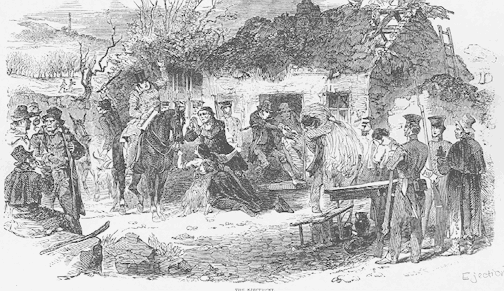 The village of Ballinglass consisted of 61 houses, solidly built and well-kept, with thick plastered walls. The inhabitants were not in arrears with their rent and had, by their industry, reclaimed an area of about four hundred acres from a neighbouring bog. On the morning of the eviction a large detachment of the 49th Infantry commanded by Captain Brown and numerous police appeared with the Sheriff and his men. Taking part in evictions was disliked by troops: a little later on April 9, at an eviction of nine families at Guitmore, Co Tipperary, a detachment of the 72nd Highlanders openly said they detested this duty and gave the people money.
The village of Ballinglass consisted of 61 houses, solidly built and well-kept, with thick plastered walls. The inhabitants were not in arrears with their rent and had, by their industry, reclaimed an area of about four hundred acres from a neighbouring bog. On the morning of the eviction a large detachment of the 49th Infantry commanded by Captain Brown and numerous police appeared with the Sheriff and his men. Taking part in evictions was disliked by troops: a little later on April 9, at an eviction of nine families at Guitmore, Co Tipperary, a detachment of the 72nd Highlanders openly said they detested this duty and gave the people money.
At Ballinglass, the people were officially called on to give up possession, and the houses were then demolished - roofs torn off, walls thrown down. The scene was frightful; women running wailing with pieces of their property and clinging to door posts from which they had to be forcibly torn; men cursing, children screaming with fright. That night the people slept in the ruins; next day they were driven out, the foundations of the houses were torn up and razed, and no neighbour was allowed to take them in.
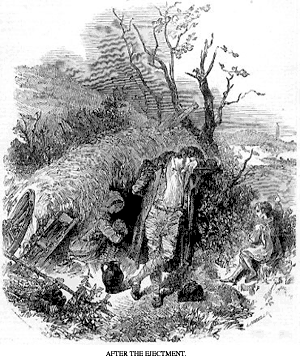 Sir Randolf Routh became Chairman of the Relief Commission in Feb 1846. The Relief Commission set up its own intelligence service and in Jan 1846 it reported complete destitution in a village in Limerick. Within a few weeks areas of West Cork reported similar starvation and an area around Skibbereen was affected, even though £50,000 of rents were collected there annually. Similar reports were coming in from all over Ireland.
Sir Randolf Routh became Chairman of the Relief Commission in Feb 1846. The Relief Commission set up its own intelligence service and in Jan 1846 it reported complete destitution in a village in Limerick. Within a few weeks areas of West Cork reported similar starvation and an area around Skibbereen was affected, even though £50,000 of rents were collected there annually. Similar reports were coming in from all over Ireland.
All over Ireland crowds were gathering declaring they were starving and mobs of women and children were attacking food stores. Indian corn was distributed but it was not enough. In the long and troubled history of England and Ireland no issue has provoked so much anger or so embittered relations between the two countries as the undisputable fact that huge quantities of food were exported from Ireland to England. Ship after ship laden with wheat, oats, cattle, pigs, eggs and butter sailed away from a country on the verge of starvation.
Relief schemes were introduced and the local officers were inundated with applications. However Trevelyan controlled everything and there were massive complications. And now, as if starvation were not enough, a new terror assailed the Irish people. The Government had been warned, in the autumn of 1846, that after famine there will follow, as a natural consequence, typhus fever or some other malignant pestilence. Fever, on a gigantic scale, was now beginning to ravage Ireland.
The corn depots were opened in May and a rush followed. But amounts available were insufficient to feed a starving people and some were in an advanced state of starvation. At the end of June Routh received directions to close the depots and the relief schemes were wound up.
Meanwhile in London dramatic events were taking place and a change of Government was imminent. On June 25th the Government of Sir Robert Peel fell, and a new Government under Lord John Russell came into power. The new Chancellor of the Exchequer was Charles Wood. He was of the same mind as Trevelyan, and both preferred to let matters take their natural course. Winding up relief was now pushed on vigorously, and on July 8th Trevelyan rejected a shipload of Indian Corn.
The new policy was received by officials in Ireland with dismay, and on August 4th Routh pressed Trevelyan to import food at once. During the first two weeks of August 1846, the potato crop failed totally in Ireland. There was total annihilation and disaster was universal.
When will they ever learn, when will they ever learn?
Where Have All the Flowers Gone, words and music by Pete Seeger
The great Irish failure of 1846 is the classic example of an outbreak of blight, and the people of Ireland, gazing over their blackened fields, despaired. They were already exhausted. What resources they possessed had been used up, and death from starvation was now a possibility. Once more, the question so frequently asked in the past was on every lip - what would the British Government do to save Ireland?. New measures for Irish relief had been in course of preparation for some weeks. The new plans were the work of Trevelyan.
Public works were again to be undertaken, and on a large scale. The British Government would no longer, as last year, bear the cost. The whole expense was to be paid by the district in which the works were carried out. Secondly the Government would not import or supply any food. Everything was to be left to private enterprise. The plan was received with consternation in Ireland. The west of Ireland, however, was to receive special treatment - here only Government food depots were to be established. Therefore, the first object of the new plans was to check the exorbitant demands of last season, they were, in fact designed not to save Ireland, but to protect England. Every detail of the new relief scheme was controlled by Trevelyan, and all letters were to be sent to him unopened. But it was in vain and too late. Famine was upon Ireland now.
At the end of July 1846 Trevelyan and Woods ordered all the schemes to be closed down. Angry demonstrations followed and labourers tore up the stretches of road they had built in many parts of Ireland. Under the new scheme thousands of projects were proposed mainly because the property owners thought that they would never have to repay the loans and they were afraid to refuse. Meanwhile starvation was everywhere.
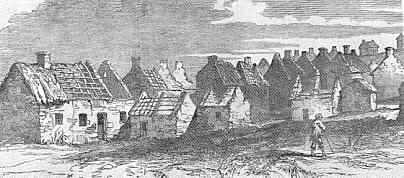
The general feeling was despair. Fear of famine was in the Irish peoples blood. Only too clearly they realised that they were helpless before the fate overtaking them, and turned blindly to those in authority for salvation, but nothing was done.
The grain harvest in Ireland in September was excellent, but it was all exported to England. The people were forced to hand over the corn to pay rent to the landlord. It was notorious that, for the Irish peasant, failure to pay his rent meant eviction. Yet even in the present emergency no protection, no period of grace was given to him. He was left to the mercy of his landlord. A number of landlords did reduce their rents, or agreed to forgo them altogether.
Near Tuam, Mr. Charles Cromie, of Annefield House, instructed his steward to arrange for all oats and grain grown on his property to be ground, and be made into meal and flour for distribution to tenants. But in nearby Ahascragh, forty seven persons were evicted by being thrown bodily out of their houses by a numerous force of constabulary. To people desperate with hunger the sight of food streaming out of the country was once more unbearable, and serious riots took place everywhere. All vessels loaded with grain or meal passing out of Ireland had to have a naval escort. Government food depots and sub-depots were guarded by police and troops. 60,000 tons would have left the country.
The work schemes were very slow to get established, and the wages were very poor. In October food prices rose to such heights that on the 6th, Magistrates of the City and Borough of Cork asked for the Government food store to be opened; the people, even those with wages, were starving because they could not pay the exorbitant prices. They were refused. But the depots were almost empty and officials were refusing to open them for sales of food, though the people were starving. Applications were being received by the hundreds. Starving people begged the Government to open depots where they might buy food at a low price.
At the end of October relief committees sent fresh and piteous appeals, as the people were living on nettles and weeds. In Roscommon the constabulary report of October 12th 1846 stated that 7,500 people were existing on boiled cabbage leaves once in 48 hours. In the west although the depots had not officially been declared open, issues were being made in badly distressed districts, but they were ordered to shut down. Autumn was now passing into winter. The nettles and blackberries, the edible roots and cabbage leaves on which hundreds of people had been eking out an existence disappeared. Flocks of wretched beings, resembling human scarecrows, had combed the blighted potato fields over and over again until not a fragment of potato that was conceivably edible remained. People were dying of starvation at an alarming rate.
And that's another reason why I left old Skibbereen
Skibbereen Song, Trad.
Lord Monteagle from Shanagolden, Co. Limerick and Father Mathew and many others made numerous appeals to Trevelyan, Routh and the Government for a humanitarian response to the famine, but their appeals fell on deaf ears. They were banging their heads against a stone wall and no relief was forthcoming. In December thousands of starving people descended on the towns and cities searching for food and shelter. Fr. Mathew wrote on December 16th that in Cork alone people died at the rate of one hundred a week. Destitute women and children were employed on the relief schemes mainly breaking stones at 4d a day. The seeds for the next year were eaten by the people, and cultivation of the land was neglected. The appalling results which must follow a shortage in the following years harvest were better appreciated in Dublin than in Whitehall. The immense number of applications for the work schemes rose with dangerous rapidity, but only a fraction of the destitute, in badly distressed districts could be given work.
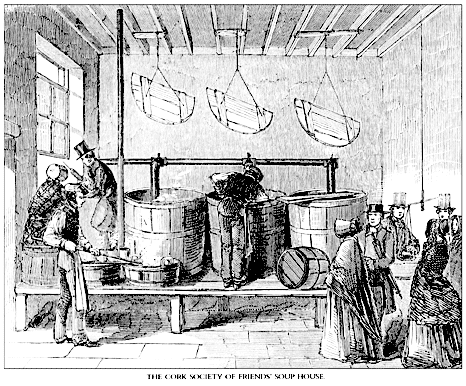 By this time assistance was being organised by bodies other than the British Government, and money and clothing were contributed for famine relief from all parts of the world. The Society of Friends, (the Quakers), set up its Central Relief Committee in Dublin. This committee decided to establish soup kitchens, which were very welcome, because hunger was everywhere and food was very scare and expensive.
By this time assistance was being organised by bodies other than the British Government, and money and clothing were contributed for famine relief from all parts of the world. The Society of Friends, (the Quakers), set up its Central Relief Committee in Dublin. This committee decided to establish soup kitchens, which were very welcome, because hunger was everywhere and food was very scare and expensive.
Starvation in Skibbereen had been reported as early as September, and on December 3rd two Protestant clergymen had a meeting with Trevelyan in London, and they begged him on their knees to send food to Ireland. Trevelyan had a pathological dislike for the Irish, and no food was sent.
On December 15th Mr. Nicholas Cummins, a well known magistrate of Cork, paid a visit to Skibbereen and the surrounding countryside and was horrified by what he saw. He wrote to the Government and the Duke of Wellington, and also sent a copy to The Times. It was published on December 24th 1846. A senior government official was ordered to Skibbereen to investigate, and he was also horrified by what he saw. Routh blamed the landlords, and Trevelyan wrote a polite letter, but nothing happened.
The depots in the West were opened, but the food was at market prices. In England a new charitable organisation named The British Association was founded, and it collected over half a million pounds for the relief of famine in Ireland. The Association bought food and clothing and distributed them through the local relief committees. In January 1847 the British Government decided to set up soup kitchens, and the scheme of relief by employment was to be abandoned. The Irish Poor Law was to be changed, so that distressed persons were to be classed as paupers. Therefore persons not inmates of a workhouse would get no food, but a scheme for outdoor relief would be introduced later in the summer.
Black '47
As we enter Black '47, as the year 1847 was called the paradox of Ireland continued. The people were dying of starvation, whilst shiploads of food were leaving the country under military escort, and merchants were making a small fortune with massive prices. The Soup Kitchen Act was preliminary to the transfer of the distressed to the Poor Law, and it was to be carried out mainly through the Irish Poor Law organisation. Though subscriptions were to be collected whenever possible, and increased by Government donations, the money spent on the soup kitchens was to come out of the rates. To collect rates in Ireland was not merely difficult - in a large number of cases it was practically impossible.
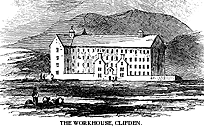 The workhouses themselves were not in a condition to become centres of relief. In the parts of Ireland which were now most distressed the workhouses, from the day they opened, had been insolvent, dirty and disorganised, and at this moment when the transfer of the destitute to the Poor Law was proposed, several were on the point of closing their doors. Scarriff, in Clare, was about to shut, and at Clifden in Galway the workhouse had actually been closed and the destitute expelled.
The workhouses themselves were not in a condition to become centres of relief. In the parts of Ireland which were now most distressed the workhouses, from the day they opened, had been insolvent, dirty and disorganised, and at this moment when the transfer of the destitute to the Poor Law was proposed, several were on the point of closing their doors. Scarriff, in Clare, was about to shut, and at Clifden in Galway the workhouse had actually been closed and the destitute expelled.
The soup kitchens were very welcome, and each person received a bowl of soup and some bread. Trevelyan thought that famine was the will of God, and he hoped that the Catholic priests would explain this to the people. They had no strength left and they believed that is was the will of God that they should die. The soup kitchens were slow to expand, and were not able to cater for the millions of starving people. Private enterprise was functioning at last, and the ample supples promised by Government were actually arriving, but they were useless to the people. Destitution and disorganisation had gone too far: Ireland was ruined, and high prices and lack of money placed the long expected food out of reach of the starving. Meanwhile, at the end of the first week in March the total number employed on the public works stood at 734,000, but the Government began to close them down. This decision produced terror, hundreds of desperate appeals poured in, but all were ignored.
Only Our Rivers Run Free
Michael McConnell
A new terror afflicted the Irish people. After the famine typhus fever or some other disease began to ravage Ireland. The main epidemic in 1847 was of typhus and relapsing fever, but at the same time other diseases afflicted starving Ireland. Dysentery, famine dropsy, diarrhoea and scurvy were horrible diseases which affected many people, resulting in agonising death. The courage of those who came to the help of the people is beyond praise. Doctors, Catholic priests, medical staff officials and many others all contacted fever and died. The work houses, fever hospitals and dispensaries did valuable work. Conditions in workhouses were very bad. Language would fail to give an adequate idea of their state. Fever patients were lying naked on straw, the living and the dead together. There was no medicine, no drink, no medical staff. In workhouses and fever hospitals, the epidemic seems to have reached its height in April, when during a single week thousands of inmates of workhouses were officially reported to have died.
About September 1847 the epidemic began to subside, when the number of people infected began to decrease. In many districts however the epidemic continued even into the following year. The total of those who died during the fever epidemic and of famine diseases will never be known, but probably ten times more died of disease than of starvation. The corpses were buried in fields, hill sides and ditches unknown to anyone.
In lonely districts fever-stricken persons died in their cabins without anyone coming near them, and their bodies were left to rot. In Clifden corpses were burned and in other districts they were buried under the cabin floor. Too many had died for a funeral service to be held.
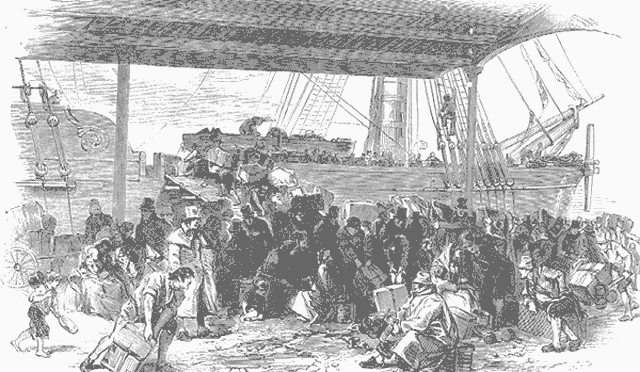 As the famine and fever intensified the minds of the Irish people turned to emigration. In a great mass movement they made their way to America and England. They left their country with hatred in their hearts for the British Government. Historians estimate that more than a million emigrated from Ireland to North America, and about the same amount emigrated to Great Britain. Many emigrated to Canada because the fares were low or the landlords paid their way. They crossed the border into America at the first opportunity.
As the famine and fever intensified the minds of the Irish people turned to emigration. In a great mass movement they made their way to America and England. They left their country with hatred in their hearts for the British Government. Historians estimate that more than a million emigrated from Ireland to North America, and about the same amount emigrated to Great Britain. Many emigrated to Canada because the fares were low or the landlords paid their way. They crossed the border into America at the first opportunity.
They were unwelcome in America because they were destitute and they were carrying fever. They sheltered in cellars, basements of houses and derelict houses etc, until they found proper housing. When they secured work they sent home money for their relatives to come out. But it was not until the second or third generation that the Irish began to establish themselves, and become successful and powerful in the country of their adoption. We mention Henry Ford, John. F. Kennedy and Ronald Reagan among the most famous people who made their mark in America.
Grosse Isle - Quebec
The roads to the ports were thronged with emigrants, and all who were able left the country. The story of the coffin ships is very well documented. A typical example of a coffin ship was overcrowding and containing no sanitary convenience of any kind. They were horrible and disgusting beyond the power of language to describe. When ships arrived at Quebec the passengers were transferred to the quarantine stations on Grosse Isle for medical inspection. They received medical treatment and the dead were buried. The emigrants embarked again for Montreal, and it was on Montreal that the inundation descended, and there they made a new life.
During 1847 the landlords began to use emigration as an alternative to eviction. Canada, or British North America as it was then called, accused them of exporting and shovelling out the helpless and infirm to the detriment of the colony. The most notorious were Lord Palmerston of Sligo and Major Mahon of Strokestown, Co Roscommon. Hordes of half-naked, starving paupers including aged infirm beggars were shipped off without regard to humanity, or even to common decency. They were given promises of clothes, food and money and told that an agent would pay 2-5 pounds to each family, depending on size, on arrival at Quebec. They arrived almost in a state of nudity. One woman was completely naked, and had to have a sheet wrapped round her before she could go ashore.
Canada was very generous to the Irish emigrants; visits of mercy to the hospitals cost Montreal valuable citizens lives. Eight Catholic Priests and the Bishop of Montreal died from fever. At the entrance to the Victoria Bridge there is a large stone with an inscription, and on Grosse Isle, there are two monuments commemorating those who died. Over a hundred thousand emigrants left Ireland for Canada in 1847. By the end of that year 20,000 had died in Canada, and 17,000 emigrants perished during the voyage, the majority from typhus.
That Isle of hunger, Isle of pain, Isle you'll never see again, but the Isle of home is always on your mind
Ellis Island, Brendan Graham
The Irish who came to America before the famine were strong able-bodied men and women ready to do manual work. The response of the citizens of the United States to the appeal for starving Ireland was on a scale unparalled in history. Over a million dollars and shiploads of food, medicines and clothing were sent. In addition the Irish emigrants and the Catholic Church also contributed over a million dollars and food and clothing. No disaster comparable to Grosse Isle occurred in the United States as a result of the famine emigrants, due to the determined measures taken by the United States authorities to prevent their country becoming overrun with thousands of starving people.
In the early summer of 1847 Boston was overrun with destitute starving Irish emigrants. Groups of poor wretches were to be seen in every part of the city, and very little was done to protect the newly landed emigrants. The first effective emigrant society was not formed until 1850. The Irish survived as best they could, living in overcrowded slums and the mortality rate among the children was huge.
The story of New York, Ellis Island and the Irish emigrants is well documented. Half the total of Irish emigration to all ports of the United States, before, during and after the famine went to New York. Vessels wishing to enter the port of New York were inspected by the port physicians. Any sick passengers or members of the crew were sent to hospital at the quarantine station. Fever, however was only one of the perils which awaited the poor emigrant in New York. He was the victim of swindlers and bullies, and at the port of New York disreputable and fraudulent practices flourished at his expense. A Board of Immigration Commissioners was appointed on May 5th 1847 for the aid and protection of emigrants arriving at the port. The Irish found work in what were termed offensive trades, and they lived in deplorable conditions until they found a more permanent home. The story of the Irish in the New World is not a romantic story of liberty and success, but the history of a bitter struggle for independence and freedom.
They don't sow potatoes nor barley nor wheat, but there's gangs of them digging for gold on the streets
The Mountains of Mourne,
William Percy French / W. Houston Collisson
The Irish in overwhelming masses crossed the Irish Channel to land at ports in England, Scotland and South Wales. This was the flight of the very poor who did not have the money for the fare to America or Canada. There was an irresistible attraction in England, as the starving were given food and would not be allowed die of hunger. Landlords were applying not for an eviction order, but for a judgement against the tenant who owed rent. He was put in prison and his wife and children were left to fend for themselves. Thousands of men, women and children were on the roads, moving towards the seaside, most of them begging their way. The main ports of arrival were Liverpool, Glasgow, Swansea, Cardiff and Newport.
In January 1847, the number of destitute Irish arriving became a deluge, but they were all treated humanely. By June 1st, 300,000 pauper Irish had landed in Liverpool, and most of them were suffering from fever which was spreading rapidly. Wretched and penniless the immigrants crept for shelter into condemned and uninhabited houses and cellars.
In the Spring of 1847 tens of thousands of Irish destitute, carrying fever with them, spread over England, Scotland and Wales, moving on from the ports, afraid of being sent back to Ireland. Not only were the Irish disliked, any hope that the misery of the destitute might evoke compassion was destroyed by fear of fever. The doors of the charitable were closed against them. The majority never escaped from destitution, but wandered around the country existing on charity and outdoor relief.
Meanwhile back in Ireland the first reduction of 20% of those employed on the works had been carried out. By June 26th the total number of labourers amounting to 734,00 were dismissed. Indian corn continued to pour across the ocean and prices slumped, but the labourers who were being turned off the public works by tens of thousands weekly, no longer had the money to buy it. The free seed scheme was a failure, and numbers of landlords were doing everything possible to get rid of destitute tenants, refusing them seed, and threatening imprisonment when rent was owed. By the middle of 1847 the soup kitchens had extended to every part of Ireland. Upwards of 3 million people were fed every day in the neighbourhood of their own homes. The harvest in September was very promising but the acreage was low, because of the lack of seed, and the labour was not there to cultivate the land.
The British Government considered that their responsibility towards the starving Irish was almost at an end. The Irish Poor Law Extension Bill legalising outdoor relief and transferring the destitute to the Irish Poor Law and the Irish Poor Rates became law on June 8th 1847. On August 15th the phasing out of the soup kitchens commenced, and by October everything was closed. Trevelyan instructed that all operations were to be wound up, and he considered that his task was finished.
At the end of 1847 England had a major financial crisis and there was no money at all available for Ireland. The Irish Poor Law Rates were impossible to collect because the landlords would not pay up. In the first week of October 1847 Trevelyan went for a few days to Dublin to confer with his officials. It was his first visit to Ireland since the famine began. The workhouses were in dire financial straits and did not have the money for food for the occupants.
Many letters of appeal from officials and the most responsible people in Ireland were received in London, all pointing out the desperate situation, but Charles Wood, Trevelyan and Lord John Russell were not to be moved. Lord Clarendon made an urgent appeal to Lord John Russell that the people must not be allowed to die of starvation. Some workhouses had collapsed. Clifden in Galway was bankrupt. It had closed down and the wretched inmates had been expelled. By the middle of December the number of destitute, half-naked and starving who were besieging the workhouses made it evident that outdoor poor relief must be renewed immediately.
The Lord-Lieutenant of Ireland warned the Government that insurrection in Ireland was at hand. Landlords, their agents and hostile officials were being shot daily and many were escaping to England. The Government introduced a Bill in the House of Commons called the Crime and Outrage (Ireland) Bill on November 29, and three bodies of 5000 men each were sent to Arklow, Clonmel and Limerick City.
The Young Irelanders
The Repeal Association was the mouthpiece and champion of the Irish masses, with branches in every town and village, and repeal wardens and repeal police in every parish. The Young Irelanders split from them, because they refused to pledge themselves never, in any circumstances to resort to physical force and armed rebellion. The leaders of the Young Irelanders were William Smith O'Brien, Charles Gavan Duffy, Thomas Francis Meagher and John Mitchel. The Young Irelanders did not succeed. The unfortunate masses of destitute were crushed by hunger, and the more prosperous were an inert mass of middle class Catholic respectability. They used their publications to incite the people to revolution, but they had no plan, no money, no arms or ammunition.The people needed food and not guns.
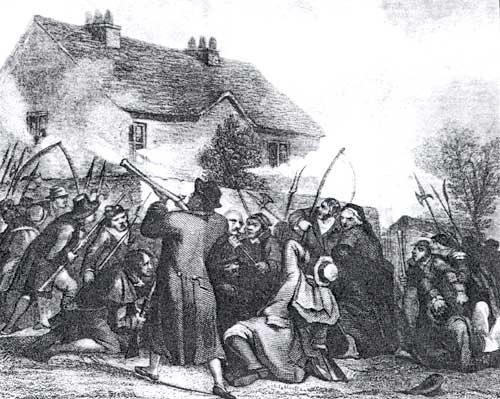
The leaders were arrested, and John Mitchel was sentenced to 14 years transportation. On May 27th 1848 he was transported to Bermuda, from which he was later transferred to Australia. The Great Revolution of 1848 ended in a scuffle between a handful of half-armed peasants and a few police in Widow McCormack's cabbage garden in Ballingarry in South Tipperary.
In 1847 only a small acreage had been planted and the crop proved superb. In the spring of 1848 potatoes were planted all over Ireland and hopes were high that the famine was over. But from the middle of June 1848, the terrible story of 1846 was repeated blow after blow and by the middle of July the catastrophe had begun. Even before the crushing blow of the new potato failure, the condition of the people was worse than in the previous year. Lord John Russell, Sir Charles Wood and Trevelyan would not advance any more money for Ireland, and all the officials were ordered to return home. On July 1st the funds of the British Association were exhausted, and the two hundred thousand children that were being fed were now left to die.
A wave of alarm swept over the country and everyone who could scrape the money together prepared to leave Ireland. A new emigration began. The emigration of 1848 was very different from the disorganised flight of 1847. A thousand a week were leaving, and comfortable farmers from Meath and Westmeath were said to be arriving in Dublin daily by the hundreds. Apparently all were of substantial class and well provided for the journey.
In Mayo thousands of acres were without a single inhabitant or animal, and in Munster large tracts of arable land were either deserted or squatted on by paupers. Substantial towns were becoming deserted, and all the respectable sections of the population were leaving. Meanwhile the wretched hordes of destitute were being treated with increasing harshness. Thousands were descending on the workhouses screaming for food and were being turned away.
On December 27th 1848, Lord Clarendon wrote to Trevelyan in despair. The first few months of 1849 saw as much destitution, if not more, than at any time since the potato failed. Jails had already become a refuge and men had committed crimes to be transported out of Ireland. The Chief Poor Law Commissioner resigned because he would not agree with a policy of extermination. Ireland lost her last remaining friend, for in June 1849 the Quakers gave up relief work. The number of people in workhouses had risen to 250,000, and the number on outdoor relief had risen to 770,000. Horrifying reports of the state of the destitute in workhouses came in. The inmates were half-naked, and were given just enough food to avoid starvation. In spite of all this the British Government remained adamant, and refused all requests for relief, and coldly persisted in a policy of extermination.
The visit of Queen Victoria in the first week of August 1849, gave the people a temporary boost, but it brought no result. Political power remained in the hands of the cabinet, and above all with the Chancellor of the Exchequer and the Treasury. The poverty of the Irish people continued, dependence on the potato continued. The treatment of the Irish people by the British Government during the famine has been described as genocide, and of wishing to exterminate a race of people.
It will never be known how many people died during the famine, and historians often come up with different figures. Before the famine the unofficial population was almost 10 million. But in 1851 after the famine it had dropped to 6.5 million. It is safe to say that one million died of starvation and two million emigrated to America and England. The greatest loss of population was in Connaught at 28.6%. The fall in population in my own parish of Knockavilla and Donaskeigh between 1841 and 1861 was 55%. The number of mud cabins was reduced by 360,000, small holdings under five acres were nearly halved, and holdings of over 15 acres doubled. Other famines followed as other famines had gone before, but it is the terrible years of the Great Famine of 1845-1849 that are remembered.
Epilogue
There are tons of original material about the famine readily available. All the speeches and writings of Government, the House of Commons, and the House of Lords are available.
All the writings of Trevelyan, the treasury officials, the media, the special reports, the vast amount of reports and pleadings from Ireland are all preserved. Ireland maintains its own archives of the famine. The Famine Museum at Strokestown and the War Museum at Ballingarry are well worth a visit.
A few modern historians tend to exonerate England from all the blame for the famine, using statistics to prove their theories. However the basic facts remain unaltered. One million died of starvation and disease. Two million were forced to emigrate, and depend on the mercy of other countries. Almost half a million homes were levelled as the people were evicted or otherwise forced to abandon them.
Four major questions occupy the minds of students, scholars, researchers, historians and many more.
- Why did they do it, and why did they put an indelible blot on the histories of England and Ireland?
- Why did landlords forcibly evict starving half-naked, bewildered people from their homes in the depths of winter, and oblige them to exist in ditches and bogholes?
- Was it all avoidable, unnecessary and preventable?
- Has Ireland sufficiently recovered from the famine?
The answer to the last question is very positive indeed. The population of the Republic has topped four million for the first time in 130 years, new figures from the Central Statistics Office have shown. The total population in April 2004 was 4.04m - the highest figure since 1871, when it stood at 4.05m - and up 64,900 or 1.6% in the last year.
The population began to fall dramatically after the Famine, sinking to its lowest level ever of 2.8m in 1961. But since then it has risen steadily, despite high emigration in the 1980s. Natural increase accounted for most of the population growth in the last year, with 33,300 more births than deaths - double the rate of a decade ago. Total births amounted to 62,000, compared to 47,000 10 years ago. Net immigration accounted for the other half of the population rise, with 31,600 more people arriving on Irish shores than departed. The total number of immigrants arriving has fallen back to 50,100 in the last year, down from its peak of 66,900 in 2002. Figures quoted above are for the 26 counties of the Republic of Ireland.
The answer to question three is easy. The Famine was totally avoidable, absolutely unnecessary and easily preventable. There was enough food in the country to feed the hungry and prevent the famine from getting its grip. The 1801 Act of Union guaranteed Ireland equal rights within the British Empire. Yet it stood idly by. The right of life is God- given. Freedom from hunger is the primary requirement in the hierarchy of human needs.
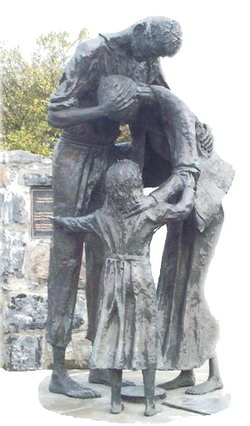 The answers to the second question are both simple and complex. They wanted to clear
off all the tenants from their estates to make way for cattle. The tenants had no rights whatsoever, and could be evicted at anytime at the whim and pleasure of the landlord. Failure to pay rent meant certain eviction and death. Mans inhumanity to man, the quality of mercy was not strained.
The answers to the second question are both simple and complex. They wanted to clear
off all the tenants from their estates to make way for cattle. The tenants had no rights whatsoever, and could be evicted at anytime at the whim and pleasure of the landlord. Failure to pay rent meant certain eviction and death. Mans inhumanity to man, the quality of mercy was not strained.
Huge volumes of literature have been produced over the past 150 years concerning the first question. The British Government, Trevelyan and the Treasury had a secret plan and hidden agenda for Ireland. They wanted to rid the country of its peasant population, and change it to a cattleranch for England. Evictions, assisted emigration and deportations to the penal colonies were in vogue. And then came the famine. England begrudged every pound it spent on famine relief, and delayed everything to the last second. An elaborate game of brinkmanship was played out between the Government, the landlords and the merchants, with the destitute caught in the middle.
Thus starvation, eviction, death, emigration and deportation were useful methods of social engineering. Mr Twisleton, the Irish Poor Law Commissioner vehemently protested and promptly resigned. Despite the calamity of the famine Ireland has excellent relations with England. Let there be peace for today and forever.
A Little Bit of Heaven
Sure a little bit of heaven fell from out the sky one day
And it nestled on the ocean in a spot so far away
And when the angels found it, sure it looked so sweet and fair
They said suppose we leave it for it looks so peaceful there
So they sprinkled it with stardust just to make the shamrocks grow
Tis the only place you'll find them no matter where you go
Then they dotted it with silver to make its lakes so grand
And when they had it finished, sure they called it Ireland.
Bibliography
The Great Hunger, Cecil Woodham-Smith. Ireland 1845 -1849. (Bestseller).
This Great Calamity, Christine Kinealy. The Irish Famine 1845-52.
A Tipperary Parish, Micheal MacCarthaigh. A History of Knockavilla-Donaskeigh.
Romantic Slievenamon, James Maher. A Tipperary Anthology.
Kilcash - Its Castle and Abbey are in ruins, but the famous poem lives on.
The Great Irish Famine, Stephen J. Campbell. Words and images from the Famine Museum, Strokestown Park, County Roscommon. Published by the Famine Museum.
The Landsdowne Estate in Kerry under W.S. Trench 1849-72. Gerard.J.Lyne
In addition to their estates in Kerry the Landsdowne family held lands in Dublin, Laois, Meath, Limerick and Offaly. In all their Irish estates amounted to some 122,000 acres, worth in 1883 about £32,000 per annum.
Graphics from the Illustrated London News of the period. See: Illustrated London News Graphics
William Stewart Trench, Land agent and author, was a highly controversial figure in his day. Appointed agent of the Landsdowne estate in Kerry just after the Great Famine, he was vilified for shipping some 4,000 destitute persons from Kenmare to the United States and Canada. The Landsdowne Estate consisted of 96,872 acres, with a valuation of £10,294.